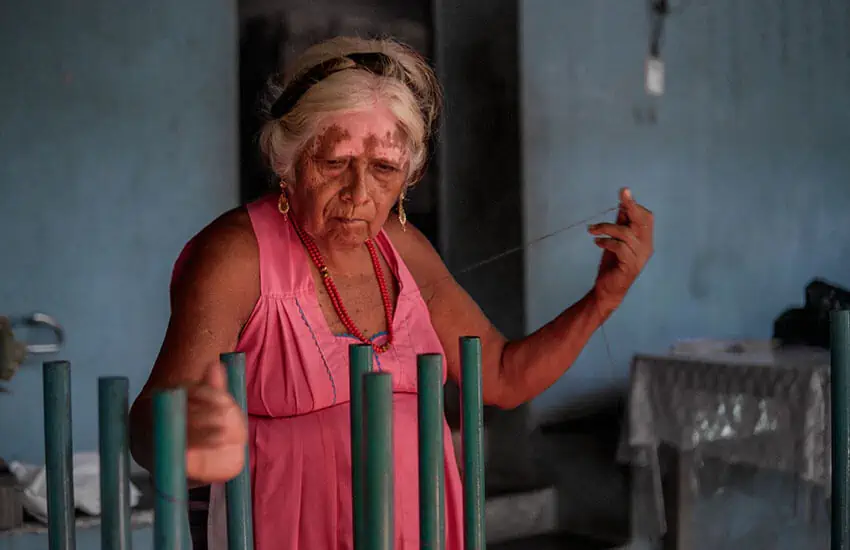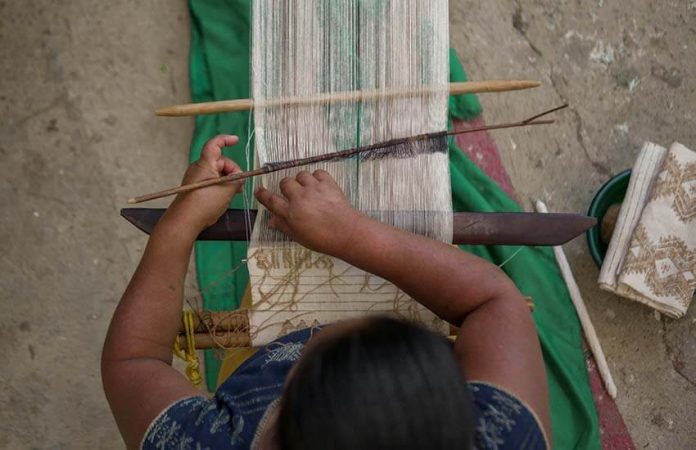Don Habacuc Avendaño was just 15 years old when he first walked eight days across Oaxaca to collect the dye of a renowned purple snail.
From the remote highlands of Pinotepa de Don Luis, Oaxaca, Avendaño descended toward Huatulco National Park, where he learned the dangerous art of collecting ink from the purpura pansa snails — an integral part of his community’s weaving traditions.
“There are a few snails, but not like before,” Avendaño lamented as he recalled the seven decades he’s been a snail dyer.
Threatened by illegal poaching and environmental concerns, his livelihood is now under threat.

Avendaño is now just one of 15 men alive, all older in age who know how to carefully extract the dye from the endangered purpura snail before returning the creature to the rocks where it continues its life cycle.
“Humans are destroying the nature around us … our work is a big example of how we can live in harmony with nature without hurting it,” his son Rafael Avendaño said.
Ocean pollution, global warming, poachers and encroaching tourism have all taken their toll on the snails.
Habacuc and Rafael’s town, Pinotepa de Don Luis, is a sleepy pueblo in northern Oaxaca whose 6,000 residents are mainly of Mixtec descent. For more than 3,000 years, the community has respected and worked alongside the snail and passed down these ancient traditions to their children.

The striking purple color also gives the Tixinda weaving collective — the women of Pinotepa de Don Luis — its recognition.
Few of the elderly weavers — identified by their striped wrap-around skirts called posahuancos and apron tops — speak Spanish and prefer to speak Mixtec. They’re one of the last remaining Mexican groups that grow and hand-spin their own cotton as well as use the sacred dye. They also color their thread with other natural sources such as the cochinilla — an insect that lives on the nopal cactus.
It takes 400 hours of work to create a huipil, intricately decorated with symbols that their ancestors revered. These symbols and patterns are also unique to each pueblo, meaning the Tixinda products are absolutely one of a kind.
From cleaning and spinning the cotton by hand, to organizing the colors, it is a laborious task to even prepare for weaving to begin.
What’s more, similar to the work of the dyers of Pinotepa de Don Luis, the ancient weaving techniques face challenges of survival within the coming generations. While many girls are encouraged to learn the traditions of their ancestors, most are less interested in pursuing this line of work.
In recent years, numbers of the endangered snails have rapidly declined — posing a challenge to the future of their Mixtec traditions and weaving. Many of the collective fear that within a decade, the snail may no longer exist at all.
“It’s illegal to harvest it, but it’s still happening and there’s no enforcement of the law,” immigration rights lawyer Patrice Perillie explained. “Their cultural identity is totally tied to this sacred color. They revere the snail; they protect it.”
Perillie has worked with the Tixinda collective for over 15 years. Inspired by the collective’s incredibly intricate artwork, Perillie is helping to raise awareness as well as helping the group sell their unique items.

“Fifteen years ago, there was no tourism in Oaxaca due to a teachers’ strike. People found out I was an immigration lawyer and asked me if I could help them go to the United States — where they would be cleaning homes and offices.”
However, Perillie had a different idea, adding: “I saw what they did … and I said, ‘No, I’m going to help you stay right here.’”
As a result, her organization, Mexican Dreamweavers, was born.
Perillie’s nonprofit group — which has been coined a reverse migration project — has opened up the Tixinda collective’s market for selling these beautiful garments. The group now has a thriving social media page, monthly huipil sales in nearby Puerto Escondido and made-to-measure orders coming in from overseas buyers.
What’s more, leaders of the group, like Habacuc, who is now head of the Cooperativo de Tintoreros de Pinotepa Don Luis dyers cooperative, have traveled to the United States to talk about their important work. Perillie’s efforts have allowed the Tixinda cooperative to gain international recognition.
However, environmental and social challenges remain, and the future survival of this 3,000-year-old Mixtec art cannot be achieved through one single route.
“It’s a question of education [and] conservation, and we want to pay the dyers to protect the snails. Then they’d make a living doing this,” Perillie said.
Despite the hurdles, the aging weavers and dyers are also optimistic about preserving their art.
“I remain hopeful that the snails can continue to reproduce. These snails don’t have to be killed or eaten,” Rafael Avendaño said. “It’s very important for the ecology of marine life … and it’s a part of our lives; it’s part of the knowledge of the Mixtecs.”
Tamara Davison is a journalist and documentary filmmaker whose work is focused on Mexico and Central America. Tamara’s work forms part of Outlawes Films, which recently produced a documentary called Dreamweavers about the work of the Tixinda cooperative.
